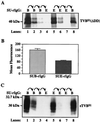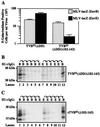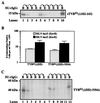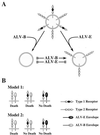Two functionally distinct forms of a retroviral receptor explain the nonreciprocal receptor interference among subgroups B, D, and E avian leukosis viruses
- PMID: 11264341
- PMCID: PMC114843
- DOI: 10.1128/JVI.75.8.3520-3526.2001
Two functionally distinct forms of a retroviral receptor explain the nonreciprocal receptor interference among subgroups B, D, and E avian leukosis viruses
Abstract
Subgroups B, D, and E avian leukosis viruses (ALV-B, -D, and -E) share the same chicken receptor, TVB(S1), a tumor necrosis factor receptor (TNFR)-related protein. These viruses, however, exhibit nonreciprocal receptor interference (NRI): cells preinfected with ALV-B or ALV-D are resistant to superinfection by viruses of all three subgroups, whereas those pre-infected by ALV-E are resistant only to superinfection by other subgroup E viruses. In this study, we investigated the basis of this phenomenon by characterizing the interaction of TVB(S1) with ALV-B Env or ALV-E Env. Sequential immunoprecipitation analysis using surface envelope immunoglobulin fusion proteins revealed the existence of two separate types of TVB(S1) that are encoded by the same cDNA clone. One form, designated the type 1 receptor, is specific for ALV-B and ALV-E. The other form, the type 2 receptor, is specific for ALV-B. We show that a protein consisting of only the first and second extracellular cysteine-rich domains of TVB(S1) is capable of forming both receptor types. However, the third extracellular cysteine-rich domain is required for efficient formation of the type 1 receptor. We also demonstrate that heterogeneous N-linked glycosylation cannot explain the difference in activities of the two receptor types. The existence of two types of TVB(S1) explains the NRI pattern between ALV-B and -E: subgroup B viruses establish receptor interference with both receptor types, whereas subgroup E viruses interfere only with the type 1 receptor, leaving the type 2 receptor available to mediate subsequent rounds of ALV-B entry. The formation of a TVB receptor type that is specific for cytopathic ALV may also have important implications for understanding how some subgroups of ALV cause cell death.
Figures





Similar articles
-
Identification and characterization of a shared TNFR-related receptor for subgroup B, D, and E avian leukosis viruses reveal cysteine residues required specifically for subgroup E viral entry.J Virol. 2000 Apr;74(8):3572-78. doi: 10.1128/jvi.74.8.3572-3578.2000. J Virol. 2000. PMID: 10729132 Free PMC article.
-
Naturally Occurring Frameshift Mutations in the tvb Receptor Gene Are Responsible for Decreased Susceptibility of Chicken to Infection with Avian Leukosis Virus Subgroups B, D, and E.J Virol. 2018 Mar 28;92(8):e01770-17. doi: 10.1128/JVI.01770-17. Print 2018 Apr 15. J Virol. 2018. PMID: 29263268 Free PMC article.
-
An NF-kappa B-dependent survival pathway protects against cell death induced by TVB receptors for avian leukosis viruses.J Virol. 2002 Jun;76(11):5581-7. doi: 10.1128/jvi.76.11.5581-5587.2002. J Virol. 2002. PMID: 11991986 Free PMC article.
-
TVB receptors for cytopathic and noncytopathic subgroups of avian leukosis viruses are functional death receptors.J Virol. 2000 Dec;74(24):11490-4. doi: 10.1128/jvi.74.24.11490-11494.2000. J Virol. 2000. PMID: 11090145 Free PMC article.
-
Avian leukosis virus subgroup J: a rapidly evolving group of oncogenic retroviruses.Res Vet Sci. 1999 Oct;67(2):113-9. doi: 10.1053/rvsc.1998.0283. Res Vet Sci. 1999. PMID: 10502478 Review.
Cited by
-
Cellular transcription factor ZASC1 regulates murine leukemia virus transcription.J Virol. 2010 Aug;84(15):7473-83. doi: 10.1128/JVI.00299-10. Epub 2010 May 19. J Virol. 2010. PMID: 20484494 Free PMC article.
-
Isolation of cell lines that show novel, murine leukemia virus-specific blocks to early steps of retroviral replication.J Virol. 2005 Oct;79(20):12969-78. doi: 10.1128/JVI.79.20.12969-12978.2005. J Virol. 2005. PMID: 16188999 Free PMC article.
-
Efficient subgroup C avian sarcoma and leukosis virus receptor activity requires the IgV domain of the Tvc receptor and proper display on the cell membrane.J Virol. 2008 Nov;82(22):11419-28. doi: 10.1128/JVI.01408-08. Epub 2008 Sep 3. J Virol. 2008. PMID: 18768966 Free PMC article.
-
Isolation and molecular characteristic of subgroup J avian leukosis virus in Guangxi and Jiangsu provinces of China during 2022-2023.Poult Sci. 2025 Aug;104(8):105272. doi: 10.1016/j.psj.2025.105272. Epub 2025 May 7. Poult Sci. 2025. PMID: 40367569 Free PMC article.
-
Receptors and entry cofactors for retroviruses include single and multiple transmembrane-spanning proteins as well as newly described glycophosphatidylinositol-anchored and secreted proteins.Microbiol Mol Biol Rev. 2001 Sep;65(3):371-89, table of contents. doi: 10.1128/MMBR.65.3.371-389.2001. Microbiol Mol Biol Rev. 2001. PMID: 11528001 Free PMC article. Review.
References
-
- Boeke J D, Stoye J P. Retrotransposons, endogenous retroviruses, and the evolution of retroelements. In: Coffin J M, Hughes S H, Varmus H E, editors. Retroviruses. Cold Spring Harbor, N.Y: Cold Spring Harbor Laboratory Press; 1997. pp. 343–435. - PubMed
Publication types
MeSH terms
Substances
Grants and funding
LinkOut - more resources
Full Text Sources

